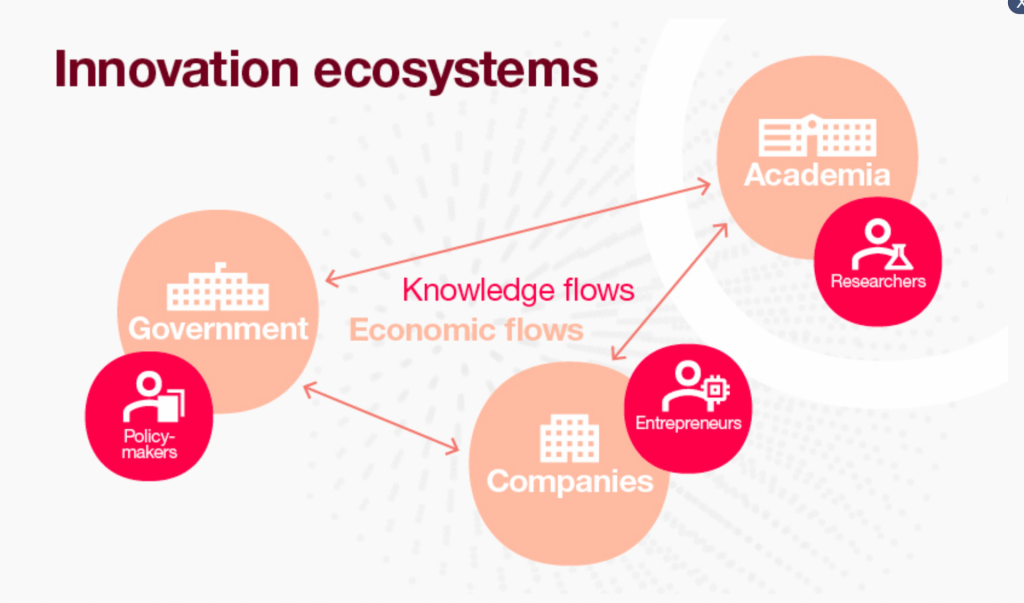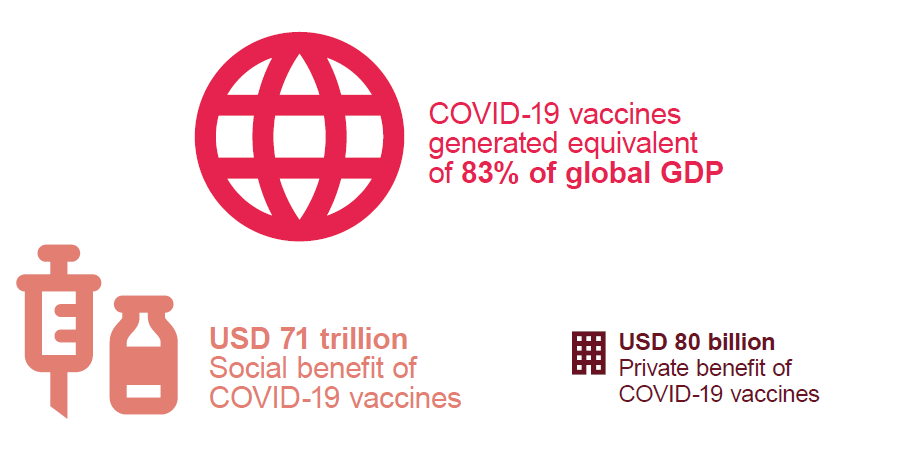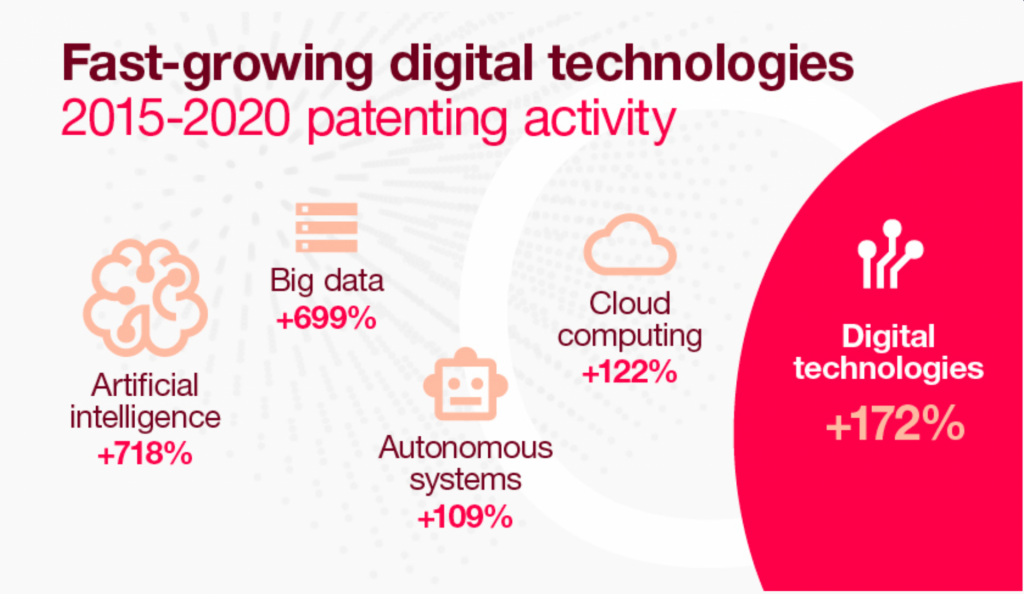
Last month saw the publication of WIPO’s new bi-annual IP report, entitled “The Direction of Innovation”. The report is packed with insights, bringing a combination of powerful observations that really hit home backed by data-driven analysis that look deeply into how and why innovation flows.
A key perspective of the report points to the split of economic benefits which go to society (social benefit) vs. returns to private sector investment (private benefit). Spoiler warning: a clear example is the lightning-paced work occurring from the time Chinese scientists sequenced and released the mapping of the SARS-CoV-2 virus in January 2020, to Covid-19 public vaccinations – barely a year later. While many may point to big pharma’s eye-popping profits, the WIPO report shows that the quantifiable portion of the economic benefits to society are roughly 900x those of the revenue earned by the private sector!

The best laid plans… how global crises affect innovation ecosystem participants
On 7 April 2022, WIPO’s IP and Innovation Ecosystems Sector (IES), hosted a short conference to present summary findings of the report, accompanied by a lively panel discussion. Marco Alemán, head of WIPO’s IES, introduced the key concept of how dependent major innovation outcomes are on the influence of each participant in the ecosystem: nations, institutional scientific and engineering research, and private sector investment. However, major events beyond the control of public policy makers shape outcomes, usually via crises, such as war, pandemic and natural disaster. Those crises have enormous impact on research and innovation outcomes. Look at how penicillin development rose in direct response to battlefield infections.
Reflecting academia, industry & government, panel’s views on setting of the direction of innovation
In introductory remarks and presentation of the panelists, Dr. Carsten Fink, head of the IES Department of Economics and Data Analysis, provided illustrations of the change in pace and focus of innovation since the industrial age. As society made its lunge forward in technology in the 20th century, it did so in recognizable big waves, i.e., engine/transport > pharma > ICT > digitalization, today.
And some funny things happened on the way to the IP forum. A most recent example is digital-related innovation: it has grown 172% faster than all patents over preceding five years.

Lively panel discussion
Introducing themselves and their work, each panelist drove home the reality of innovation acceleration. The panelists included Victor Aguilar, Procter & Gamble’s Chief R&D and Innovation Officer, Dr. Xiaolan Fu, Professor and Founding Director of Oxford University’s Technology & Management Centre for Development, David Kappos, Partner at Cravath, Swaine & Moore, and former Director of the USPTO, and Caroline Ylitalo, Division Scientist at 3M. Here a few items that resonated with me:
Views from academia, industry and public sector
- Dr. Fu highlighted the case of under-the-radar innovation taking place in developing economies, and how digitalization is changing adoption patterns into and out of LDCs. But it’s not only permeability and diffusion that are changing, it’s also about the impact on labor and the growth in services from disembodying know-how and delivering expertise digitally.
- From the corporate side, 3M’s Caroline Ylitalo spoke of major challenges and trends we face as society. She highlighted the impact of crisis and the opportunities they may arise from it, shown in the surge in demand for N95 masks, and visible also in the utility gains from the digital world’s access to masses of technical information, along with the advent of ideation tools and collaboration platforms.
- P&G’s Victor Aguilar drove home the point of digitalization’s impact for P&G’s goal of improving life, ranging from AI’s contribution to retailing optimization, to its role in designing smart toothbrushes, and to the increasing importance of identifying relevant innovation arising outside P&G.
- Cravath’s David Kappos highlighted how dependent the realization of huge economic output and the delivery of the benefit to society are on making sure ecosystems’ participants do what they do best (per their respective missions)
- Private sector develops suitable commercially defensible applications,
- Inventors and their institutions need access to the tools – including collaborative networks – to help convert their innovative insights into invention disclosure and products
- Governments alone needs to provide money and structure of well-reasoned incentives to grow and make accessible the bounty of fundamental research;the private sector’s need to provide returns to owners makes investment in basic research prohibitive.
Public and private motivations: even if not aligned, good neighbors enable a productive existence
The role of government policy and its ability to create a fertile bed of fundamental research is a topic receiving significant attention. And well it should. Thoughtful and economically supportive public policy for fundamental research can produce huge big social benefits. Once they’re convinced of the business potential prospects, the private sector gets busy converting discoveries from a trove of basic research into commercialized inventions. That’s not all, as “de-risked” innovations come into focus, industry dramatically increases its share of development expense.
Beginning in the 1950s, the space race led to the creation of NASA in the US and its enormous role in driving aerospace research and creating in the process a rich network of public-private collaboration. Sponsored research was involved of course, but government purchases of innovation-based products from the private sector – there was no other buyer – were also a critical factor in clearing a path to commercialization of those space-age inventions.
Enormous productivity flowed from that inventive output which created social benefits many times those of the gains for the private sector in a broad array of fields, such as energy storage, photovoltaics and nuclear energy.
The grand challenges facing us and the need to pay attention to the direction of innovation
As the world faces climate change, ongoing food insecurity, the need for higher levels of education and the preservation of privacy rights, to name some big ones, government can play an important role. While the public sector can’t do a great job of predicting private sector winners, it can do things to even out the playing field through incentives, such as by purchasing from innovative smaller firms willing to take the risk of developing emerging technology.
There is so much inside this report, I am moved to invoke lyrics from OMC’s 1995 hit single, How Bizarre, but with a twist: you don’t need to “buy the rights”, WIPO grants you a free readership license, so download their great Intellectual Property Report 2022: The Direction of Innovation – and enjoy its valuable insights.
BTW, keep an eye out for a future SeedSprint blogpost where we’ll get more into the weeds on a topic WIPO cares a lot about: increasing the efficiency of the critical interplay between innovation-seeking large enterprise on one side, and technology providers on the other, i.e., institutional intermediaries such as TTOs, along with risk-taking micro and SMEs (MSMEs) in the private sector.



